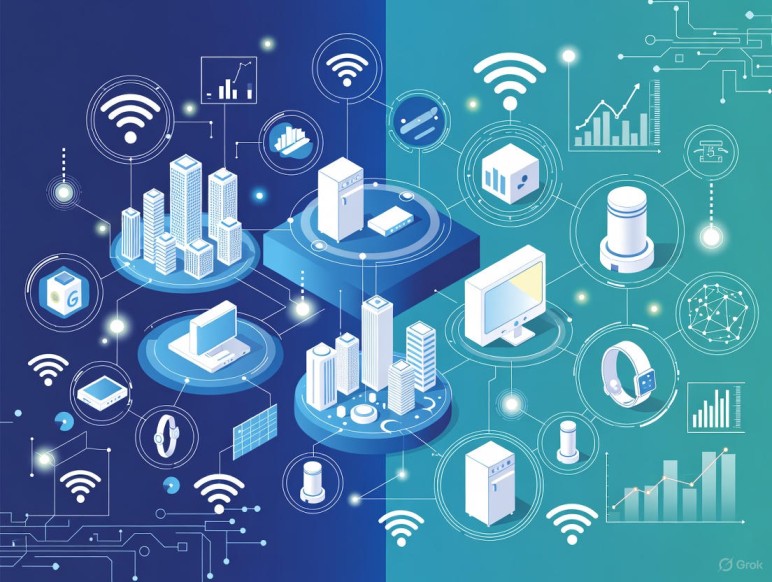IoT’s Next Big Leap: How Connected Technology Is Shaping India’s Future

India’s Internet of Things (IoT) ecosystem is entering a pivotal growth phase, accelerated by nationwide digital initiatives, 5G availability, and increasing adoption across industries. As businesses push for automation and governments scale smart-city programs, IoT is steadily becoming part of everyday life. This transformation signals a major shift that could redefine India’s digital economy over the next decade.
Background: A Market Poised for Expansion
The last few years have seen India ramp up efforts in digital infrastructure—from the Smart Cities Mission to the Digital India program. Affordable mobile data, rising smartphone penetration, and cloud adoption have laid the groundwork for large-scale IoT deployment. Manufacturing, healthcare, logistics, and agriculture are already experimenting with connected systems to improve efficiency.
Key Developments Driving IoT Adoption
India’s IoT landscape is being shaped by several critical developments:
- 5G rollout: Low-latency, high-speed networks are enabling real-time data transfers needed for autonomous systems, remote monitoring, and industrial automation.
- Smart city acceleration: Urban centres are deploying IoT-powered solutions for traffic management, public safety, energy optimization, and waste monitoring.
- Industrial IoT growth: Factories are increasingly adopting sensors, robotics, and predictive maintenance systems to reduce downtime and boost productivity.
- Healthcare transformation: IoT wearables and remote diagnostic tools have seen a surge in adoption, especially post-pandemic.
- Agritech innovations: Connected irrigation systems, soil sensors, and weather-based automation tools are improving farm outputs.
Experts note that India could become one of the world’s largest IoT markets by the end of this decade as device affordability improves and enterprises scale deployments.
Technical Explanation: How IoT Works in India’s Context
IoT refers to interconnected devices—such as sensors, machines, and appliances—that communicate through the internet. In India, these systems often rely on cellular networks, Wi-Fi, LPWAN technologies like LoRaWAN, and now 5G. Once deployed, devices collect data, which is processed via edge computing or cloud platforms, enabling automation and insights.
For example:
A smart meter in a city can automatically send consumption data to the utility provider. An agricultural soil sensor can trigger irrigation only when moisture levels drop, saving water.
Implications: Why India’s IoT Growth Matters
A thriving IoT ecosystem can:
- Boost economic productivity through automation and data-driven decision-making.
- Improve quality of life with better transportation, healthcare, and city management.
- Create millions of tech jobs in hardware, software, analytics, cybersecurity, and manufacturing.
- Strengthen India’s global competitiveness in emerging technologies.
- Support sustainability goals through optimized energy and resource usage.
Challenges and Limitations
Despite strong potential, IoT adoption faces hurdles:
- Cybersecurity risks: More connected devices mean greater exposure to breaches.
- Lack of standardization: Interoperability across device manufacturers remains limited.
- Infrastructure gaps: Rural areas still struggle with reliable connectivity.
- High deployment costs: Small businesses may find IoT implementation expensive.
- Data privacy concerns: Clearer policies and regulations are needed to protect consumers.
Addressing these issues will be crucial for sustainable, secure, and large-scale IoT adoption.
Future Outlook: A Decade of Transformation Ahead
Over the next five to ten years:
- IoT will integrate deeply with AI, edge computing, 5G, and robotics.
- Smart city projects will expand to Tier-2 and Tier-3 cities.
- Industry 4.0 deployments will become mainstream.
- Consumer IoT devices—from smart home products to wearables—will become more affordable.
- Policy reforms may establish unified IoT standards, boosting trust and adoption.
If these trends continue, India could evolve into a global IoT innovation hub.
Conclusion
The future of IoT in India is poised for exponential growth. With the right mix of infrastructure, policy support, and industry collaboration, IoT can become a driving force behind economic development, innovation, and improved living standards.
As the digital shift accelerates, India’s connected future is closer than ever.